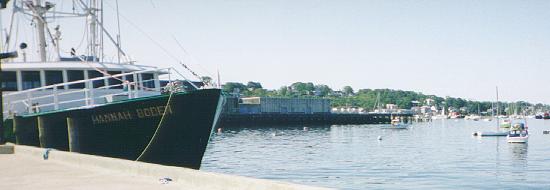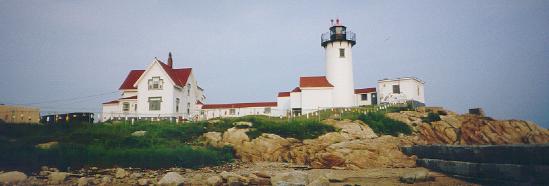 |
| CHAPTER 7: EAST GLOUCESTER TO BASS ROCKS: Via Rocky Neck and Eastern Point |
 Originally forested with oak, then bared of trees by early settlers axes, Eastern Point is once again thick with trees -- at least in between the houses. In the foreground is the sister swordfish boat to the Andrea Gail, lost at sea with all hands in the No-Name storm of 1991, chronicled by Sebastian Junger in his bestseller, "The Perfect Storm." Before the village here got so grand (after the railroad came from Salem in 1847) as to be called East Gloucester, the whole peninsula that makes the harbor was Eastern Point. It's a mile wide and two and a half long, as the herring gull flaps, from the head of Cripple Cove (a cripple is a swampy thicket) at the bottom of Point Hill, where East Main, Sayward, and Haskell streets collide, out to Dog Bar Breakwater. That's the length of Gloucester Harbor, in two parts. The Outer Harbor between the shores of Eastern Point and West Gloucester is a mile across and almost two long into Pavilion Beach. The Inner Harbor, "safe from all winds that blow," as an old almanac describes it, is a third of a mile across between waterfronts. That's a lot of harbor. This whole peninsula is Cape Ann's cape, displaying the variety, the pockets of paradox, the successes and the failures of the greater Gloucester as on a stage. The important thing about it is the Atlantic Ocean. That's where it gets its fog, and its vitality. East Main Street Not much to look at today, but fifty years ago the waterfront from the Ben Smith Playground on Cripple Cove, where there is a high-tide public landing reached on foot, to the bend beyond Hammond Street was all Gorton-Pew Fisheries. In its glory as a salt-fish producer, Gorton's was a thumping, squeaking, grinding, steaming, chugging, sprawling combine of the Slade Gorton, John Pew, D. B. Smith, and Reed and Gamage companies that kept dozens of wharves and acres of flake yards busy with the unloading, filleting, salting, drying, boning, cutting, grinding, smoking, boxing, packaging, and canning of the millions upon millions of pounds of fish brought back from the North Atlantic banks by their fleets of handsome Gloucester schooners. Along this part of East Main Street, Gorton's processed redfish during the boom that revived the lagging industry in World War II; it kept a smokehouse here, and a plant that turned out codfish cakes by the mile. Ah, that salt fish spread on the flakes, curing in the hot sun, gave off a pungency that in the recollection quickens the pulse and puts the veteran waterfront man in mind of schooners laying to the wharves, sails drying, and the thump-thump of handcarts over loose planks.  Eastern Point Light, with the beginning of Dog Bar Breakwater at its foot. Lighthouse, Breakwater, and Mother Ann In colonial days a sentinel grove of oaks marked the end of Eastern Point for mariners. This succumbed to time and tempest, and in 1829 the federal government bought an acre and built a stone day beacon, to which a whale oil lamp and a cottage for Keeper Samuel Wonson were added two years later. The lighthouse was built anew on its old foundation in 1848; it was rebuilt in 1890 as it is today, fifty-seven feet above sea level, visible on a clear night thirteen miles (map 7, 12). The revolving lantern and fog bell were first operated by hand-wound clockworks. These gave way to electric motors. A bell was added to the wooden light structure on the far end of Dog Bar Breakwater. Then a radio beacon by the lighthouse. The bells were replaced by electronic horns whose bleats combine in a doleful chorus with the sighs of Mother Ann's Cow, the whistling buoy to the southward. In 1985 everything was automated, and the lighthouse cottage, after a hundred and fifty-four years of occupation by a succession of faithful keepers, was converted to quarters for personnel from the Coast Guard station up in the harbor. The Breakwater, long agitated for, was built 2,250 feet over Dog Bar by the Army Engineers as Congress doled out the funds between 1894 and 1905. Before the granite foundation broke high water, nearly forty confused sailing vessels came to grief on it, some forever. Open from sunup to sundown in calm weather, it's an exciting walk out into the middle of the harbor and a favorite spot for fishing for flounder, mackerel, and pollock. When the swells are breaking over it thirty or forty feet high in the fury of an easterly gale, and the whistler shrieks its distress, it hardly needs mentioning that Dog Bar Breakwater is closed to the public. |
   |
The Gloucester Guide, Copyright © 1990 by Protean Press and Joseph E. Garland. |